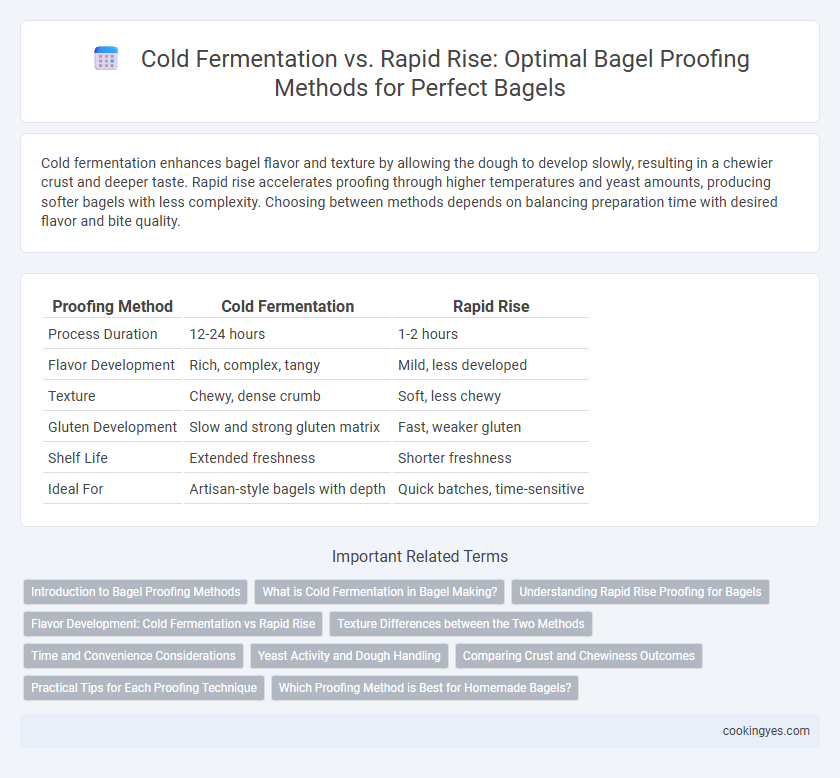Cold fermentation enhances bagel flavor and texture by allowing the dough to develop slowly, resulting in a chewier crust and deeper taste. Rapid rise accelerates proofing through higher temperatures and yeast amounts, producing softer bagels with less complexity. Choosing between methods depends on balancing preparation time with desired flavor and bite quality.
Table of Comparison
| Proofing Method | Cold Fermentation | Rapid Rise |
|---|---|---|
| Process Duration | 12-24 hours | 1-2 hours |
| Flavor Development | Rich, complex, tangy | Mild, less developed |
| Texture | Chewy, dense crumb | Soft, less chewy |
| Gluten Development | Slow and strong gluten matrix | Fast, weaker gluten |
| Shelf Life | Extended freshness | Shorter freshness |
| Ideal For | Artisan-style bagels with depth | Quick batches, time-sensitive |
Introduction to Bagel Proofing Methods
Cold fermentation enhances bagel flavor and texture by allowing yeast to develop slowly over 12-24 hours at low temperatures, producing a chewier crust and deeper taste profile. Rapid rise proofing uses warm temperatures to speed yeast activity, reducing proofing time to 1-2 hours but often resulting in a softer texture and less complex flavor. Understanding these methods helps bakers balance time efficiency with traditional bagel qualities.
What is Cold Fermentation in Bagel Making?
Cold fermentation in bagel making involves allowing the dough to slowly ferment at low temperatures, typically between 38degF and 45degF (3degC to 7degC), over 12 to 24 hours. This process enhances flavor development through extended enzymatic activity and yeast fermentation, resulting in a chewier texture and richer taste. Cold fermentation also improves dough structure, making it easier to shape and yielding a distinctive bagel crust after boiling and baking.
Understanding Rapid Rise Proofing for Bagels
Rapid rise proofing for bagels significantly shortens the fermentation process by using higher temperatures and accelerated yeast activity, resulting in quicker dough expansion. This method produces bagels with a softer texture and less complex flavor compared to cold fermentation, which develops more depth through slower yeast fermentation. Rapid rise is ideal for bakers needing faster turnaround times while maintaining a traditional bagel shape and chewiness.
Flavor Development: Cold Fermentation vs Rapid Rise
Cold fermentation in bagel proofing enhances flavor development by allowing enzymes and yeast to slowly break down starches and proteins over 12 to 24 hours, creating complex, nuanced taste profiles. Rapid rise methods, typically completed within 1 to 2 hours using higher yeast levels or warm temperatures, produce a milder flavor with less depth and reduced aroma complexity. The extended enzymatic activity in cold fermentation contributes to superior chewiness and a richer, tangier bagel crust compared to the softer, less flavorful results of rapid proofing.
Texture Differences between the Two Methods
Cold fermentation develops a chewier, denser texture in bagels by allowing enzymes to break down starches and proteins gradually, enhancing gluten structure. Rapid rise produces a lighter, fluffier bagel texture due to quicker yeast activity and less time for gluten development. This difference in fermentation time significantly impacts the traditional bagel's characteristic chewiness and crust formation.
Time and Convenience Considerations
Cold fermentation for bagel proofing typically requires 12 to 24 hours in the refrigerator, allowing complex flavors and chewy texture to develop while offering flexibility for scheduling. Rapid rise methods accelerate fermentation to about 1 to 2 hours at room temperature, providing convenience for quick preparation but often sacrificing depth of flavor. Choosing between cold fermentation and rapid rise depends on balancing time availability and desired bagel quality.
Yeast Activity and Dough Handling
Cold fermentation enhances yeast activity by slowing fermentation, allowing complex flavor development and improved gluten structure in bagel dough. Rapid rise accelerates yeast activity through warmer temperatures, leading to quicker proofing but less depth in texture and flavor. Dough handling is easier with cold fermentation since the dough is firmer and less sticky, while rapid rise produces softer dough that can be more challenging to shape.
Comparing Crust and Chewiness Outcomes
Cold fermentation produces bagels with a thicker, chewier crust due to the extended fermentation time allowing complex flavor development and gluten strengthening. Rapid rise methods yield a lighter, less dense crust with a softer chew, as the dough proofs quickly without extensive gluten network formation. Choosing cold fermentation enhances the traditional bagel's characteristic chewiness and crust depth, while rapid rise prioritizes speed over texture complexity.
Practical Tips for Each Proofing Technique
Cold fermentation for bagels enhances flavor development and creates a chewier texture; refrigerate the dough for 12-24 hours and allow it to come to room temperature before shaping. For rapid rise, proof the dough in a warm environment at 75-80degF for 1-2 hours to quickly achieve volume but with less complex flavor. Use cold fermentation for artisanal-quality bagels and rapid rise when time is limited, adjusting hydration and baking times accordingly.
Which Proofing Method is Best for Homemade Bagels?
Cold fermentation enhances the flavor and texture of homemade bagels by allowing a slow, controlled rise over 12 to 24 hours, resulting in chewier crusts and more complex, developed taste. Rapid rise proofing, completed within 1 to 2 hours at warmer temperatures, offers convenience but often sacrifices depth of flavor and crust authenticity. For bakers seeking traditional bagel characteristics with optimal crumb and chew, cold fermentation is the preferred proofing method.
Cold Fermentation vs Rapid Rise for Bagel Proofing Infographic

 cookingyes.com
cookingyes.com